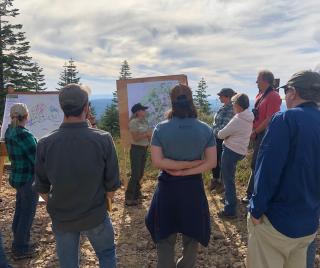Conservation Finance Program
Housed in the USDA Forest Service National Partnership Office, the Conservation Finance Program’s mission is to increase and unlock new sources of funding and financing for agency priorities. While the Forest Service broadly defines conservation finance as the practice of raising, managing, and deploying capital for conservation outcomes, the program focuses on developing innovative finance models that engage private capital. This is done through models that set up return-driven investment opportunities that align environmental, social, and financial outcomes. These models support the USDA Secretary’s Agriculture Innovation Agenda, which promotes innovative solutions designed to maximize results while ensuring accountability.
How Does Conservation Finance Benefit the Forest Service?
Focus on partnership models that generate investment opportunities enables the agency to access a new sector of capital – private capital – that can:
- Accelerate pace and scale of priority work. Conservation finance models raise capital to cover project costs upfront. This accelerates the pace of project completion, increases the scale of landscapes served, and enhances effective delivery of benefits to the public.
- Leverage resources at multiple levels. Conservation finance models leverage appropriated dollars to engage philanthropic and private capital. This leverage increases and diversifies resources to achieve the agency’s mission.
- Promote Shared Stewardship. Developing and implementing conservation finance models involves many stakeholders, including project developers, investors, beneficiaries, researchers, and implementation partners. Partnership on conservation finance projects also seeds broader collaboration, promoting Shared Stewardship of National Forest System lands and cost-sharing among stakeholders.
- Advance outcomes-based decision-making. Conservation finance models rely on the measurement of ecological and economic data that can be used to make the business case for stakeholder involvement and investment, prioritize land management activities to maximize outcomes, and measure linkages between financial investment and social/environmental outcomes.
The Conservation Finance Program is working to:
- Cultivate a portfolio of pilot projects to generate lessons learned and demonstrate success for conservation finance partnerships
- Build agency capacity and expertise to apply conservation finance models that support priority work on NFS and adjacent lands
- Develop a policy framework that supports and enables enduring conservation finance partnerships
- Chart a path to scale for conservation finance models to address landscape-level challenges
Conservation Finance Project Case Study
In fall 2018 Forest Service partner Blue Forest Conservation launched the first Forest Resilience Bond (FRB) project in collaboration with the Tahoe National Forest and National Forest Foundation. The FRB is a public-private partnership model that enables private capital to cover the upfront cost of implementing forest restoration activities like thinning and prescribed burning that reduce wildfire risk and protect water resources in landscapes with high fire risk. The FRB raises investor capital to finance pre-planned forest health treatments and uses a collaborative framework that brings together stakeholders who benefit from restoration to share the cost of reimbursing investors as work is completed.
On the Tahoe National Forest, the FRB provides $4 million in private capital from four investors to finance ecological restoration treatments that reduce wildfire risk across 15,000 of National Forest System land. The State of California and a municipal water and hydroelectric utility, Yuba Water Agency, are repaying investors at contracted rates as the restoration work is completed and outcomes are achieved. The Tahoe National Forest is providing in-kind support and funding for project planning, development, and implementation through a Master Stewardship Agreement with the National Forest Foundation, the project’s primary implementation partner. With FRB financing in place this project will likely be completed in four years, much faster than the 10 to 12 years it would otherwise have taken. Collaboration around this project also laid the groundwork for nine federal, state, tribal, and NGO partners to establish the North Yuba Forest Partnership, a collaborative focused on planning, financing, and implementing forest restoration across 275,000 acres of the watershed.
Learn more about the Tahoe project here!

